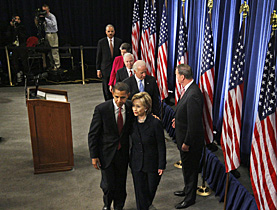
Swiss “CSIs” help US secret service

Any suspicious handwritten letters to United States President Barack Obama or other top US officials are now analysed using a technique developed by Swiss scientists.
Researchers from Lausanne University are the brains behind the Digital Ink Library, a high-tech database of 10,000 different inks collected by the US secret service over the past 40 years.
“The US secret service deal with all kinds of litigious correspondence like anonymous letters to the president or to influential members of the government,” Christophe Champod, professor at Lausanne University’s School of Criminal Justice, told swissinfo.ch.
“They often have to deal with handwritten documents; and the primary information they are interested in is what they can say to their field officers about what model or kind of pen was used.”
This kind of information can help officers narrow down a suspect list. Ink evidence was thought to have been used to help successfully identify army biological researcher Bruce Ivins as the person responsible for creating and mailing bacterial spores that killed five people in the 2001 anthrax attacks in the US.
A team of Lausanne researchers, together with the Basel firm CAMAG – the world leader in chromatography – took two years to put together the Digital Ink Library for the US secret service, which has been in use since February 2009.
The digital library was created from an ink collection belonging to the US secret service that dates back to the 1960s.
“Basically they go into shops and buy pens and analyse the ink,” said Swiss forensic scientist Cédric Neumann.
Collecting clues
Using chromatography, scientists are able to reveal the chemical components of a certain kind of ink and build up clues about where it came from, when it was introduced and even the type of pen used.
The set of 10,000 different ink samples and their related information used to be stored in hundreds of files in huge cupboards.
Manually searching and analysing specific ink was therefore a very laborious process, said Neumann.
“We designed a system that can measure and analyse the information digitally, so that you can store it on a hard disk and look through the files automatically using mathematics and statistics,” said Neumann.
The time it takes to analyse a suspect ink sample has been cut from two days to five minutes, he added.
Long-term ties
The origins of this ultra-sensitive project date back to 2000, when the US intelligence services came knocking at Neumann’s door in Lausanne.
“There are long ties between the US secret service and Lausanne University,” Neumann explained. “Their chief scientist comes to Switzerland about once or twice a year. He visited in 2000 and I showed him what I was doing.”
Lausanne’s School of Criminal Justice, which this year celebrates its 100th birthday, has close research ties with numerous foreign police and intelligence agencies, including the US secret service, the FBI and the British Forensic Sciences Service.
Neumann was invited to join the US secret service in 2001 as an intern. But after the September 11 attacks he was forced to change his plans and continue the project from Switzerland.
“Because of my citizenship they couldn’t keep me but they were interested in my work, so they basically funded my research,” he explained. “It was a really good experience. Once I gained their trust I had large freedom to deliver what I was supposed to.”
The secret service remains hush hush about their new high-tech toy, however.
“It’s part of the general secrecy,” said Champod. “No operational feedback.”
Neumann is currently working for the British Forensic Sciences Service on a new system to measure fingerprint statistics to show how fingerprint evidence still retains its power and reliability.
“We are now finishing the maths and I have a team working on software like on TV where you put an image on the computer and you mark different features,” he said.
“There is a massive gap between the TV show, [CSI: Crime Scene Investigation], and the real forensic world. But there are a few of us trying to make the TV show a reality,” said Neumann.
Simon Bradley, swissinfo.ch
The School of Criminal Justice at Lausanne University was founded by Rodolphe Archibald Reiss in 1909.
It was the world’s first scientific police school and is still one of the few institutions in Europe to offer complete training in forensic sciences. It is also the only university institution in Switzerland to offer full training in criminology.
The school offers a Bachelor and a Master of Science in Forensic Science, a Master of Law in Criminal Justice and in Legal Issues, Crime and Security of New Technologies, as well as a PhD in Forensic Science and in Criminology.
The school consists of 10 professors, 70 research assistants and around 400 students.

In compliance with the JTI standards
More: SWI swissinfo.ch certified by the Journalism Trust Initiative






























You can find an overview of ongoing debates with our journalists here . Please join us!
If you want to start a conversation about a topic raised in this article or want to report factual errors, email us at english@swissinfo.ch.